Related Research Articles

The American Locomotive Company was an American manufacturer of locomotives, diesel generators, steel, and tanks that operated from 1901 to 1969. The company was formed by the merger of seven smaller locomotive manufacturers and Schenectady Locomotive Engine Manufactory of Schenectady, New York. A subsidiary, American Locomotive Automobile Company, designed and manufactured automobiles under the Alco brand from 1905 to 1913. ALCO also produced nuclear reactors from 1954 to 1962.


Under the Whyte notation for the classification of steam locomotives, 4-6-2 represents the wheel arrangement of four leading wheels on two axles, six powered and coupled driving wheels on three axles and two trailing wheels on one axle. The 4-6-2 locomotive became almost globally known as a Pacific type after a New Zealand locomotive that was shipped across the Pacific Ocean.
Under the Whyte notation for the classification of steam locomotives, 2-10-2 represents the wheel arrangement of two leading wheels, ten powered and coupled driving wheels, and two trailing wheels. In the United States of America and elsewhere the 2-10-2 is known as the Santa Fe type, after the Atchison, Topeka and Santa Fe Railway that first used the type in 1903.
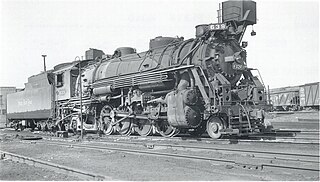
Under the Whyte notation for the classification of steam locomotives, 2-8-2 represents the wheel arrangement of two leading wheels on one axle, usually in a leading truck, eight powered and coupled driving wheels on four axles and two trailing wheels on one axle, usually in a trailing truck. This configuration of steam locomotive is most often referred to as a Mikado, frequently shortened to Mike.
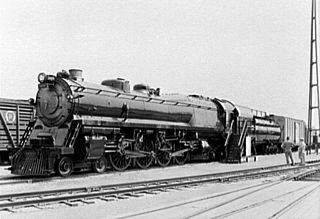
A 4-4-4-4 steam locomotive, in the Whyte notation for describing locomotive wheel arrangements, has a four-wheel leading truck, two sets of four driving wheels, and a four-wheel trailing truck. While it would be possible to make an articulated locomotive of this arrangement, the only 4-4-4-4s ever built were duplex locomotives—with two sets of cylinders driving two sets of driven wheels in one rigid frame, essentially a 4-8-4 with divided drive.
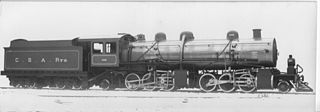
Under the Whyte notation for the classification of steam locomotives by wheel arrangement, a 2-6-6-2 is a locomotive with one pair of unpowered leading wheels, followed by two sets of three pairs of powered driving wheels and one pair of trailing wheels. The wheel arrangement was principally used on Mallet-type articulated locomotives, although some tank locomotive examples were also built. A Garratt locomotive or Golwé locomotive with the same wheel arrangement is designated 2-6-0+0-6-2 since both engine units are pivoting.
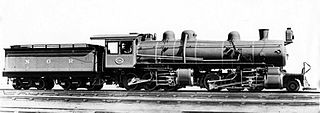
Under the Whyte notation for the classification of steam locomotives by wheel arrangement, 2-6-6-0 is a locomotive with one pair of unpowered leading wheels, followed by two sets of three pairs of powered driving wheels and no trailing wheels. The wheel arrangement was principally used on Mallet-type articulated locomotives. Some tank locomotive examples were also built, for which various suffixes to indicate the type of tank would be added to the wheel arrangement, for example 2-6-6-0T for an engine with side-tanks.

The NZR A class were a class of steam locomotives built in 1906 with a 4-6-2 wheel arrangement for the New Zealand Railways Department (NZR). The class should not be confused with the older and more obscure A class of 1873. They were designed by the NZR's Chief Mechanical Engineer, A. L. Beattie and his Chief Draughtsman, G. A. Pearson to replace less powerful locomotives struggling with increasing loads on the South Island Main Trunk Railway, and in anticipation of the traffic volumes that would be created upon the completion of the North Island Main Trunk railway.
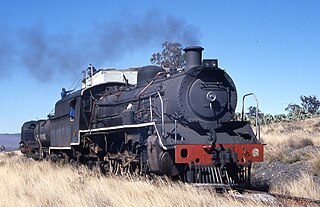
The South African Railways Class 19B 4-8-2 of 1930 was a steam locomotive.

The South African Railways Class MF 2-6-6-2 of 1911 was a steam locomotive from the pre-Union era in Transvaal.
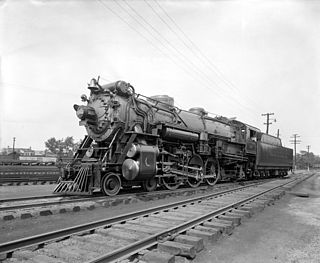
The Southern Railway Ps-4 was a class of 4-6-2 steam locomotives built for the Southern Railway, as well as its subsidiaries, the Alabama Great Southern Railroad and the Cincinnati, New Orleans and Texas Pacific Railway. The locomotives were notable for their green with gold trim liveries, and have been regarded by Smithsonian curator John H. White Jr. as being "among the most celebrated passenger locomotives operated in the United States...."
Maine Central Railroad Class W locomotives were intended for heavy freight service. They were of 2-8-0 wheel arrangement in the Whyte notation, or "1'D" in UIC classification. They replaced earlier class O 4-6-0 locomotives beginning in 1910. They were in turn replaced by class S 2-8-2 locomotives for the heaviest freight service beginning in 1914, but remained in use on lighter freight trains until replaced by diesel locomotives after World War II.
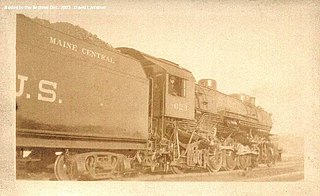
Maine Central Railroad Class S locomotives were intended for heavy freight service. They were of 2-8-2 wheel arrangement in the Whyte notation, or " 1'D1' " in UIC classification. They replaced earlier class W 2-8-0 locomotives beginning in 1914. They were the largest and most modern steam freight locomotives built for Maine Central; although former Boston and Maine Railroad 2-10-2s were later purchased to handle World War II freight traffic. Class S locomotives pulled freight trains over the main line between Portland and Bangor, Maine; and are best remembered for service on the Mountain Division from 1929, when the class X Mallet locomotives were scrapped, until replacement by diesel locomotives in the early 1950s.
Maine Central Railroad Class C locomotives were intended for main line passenger service. They were of 4-6-2 wheel arrangement in the Whyte notation, or " 2'C1' " in UIC classification. They replaced earlier class N 4-6-0 locomotives beginning in 1907. Class C locomotives pulled named passenger trains until replacement by diesel locomotives after World War II.
Maine Central Railroad steam switchers were designated Class K. They were of 0-6-0 wheel arrangement in the Whyte notation, or "C" in UIC classification. American Locomotive Company (ALCO) began building more powerful yard locomotives for Maine Central in 1909. Twenty locomotives numbered 161 through 180 were active in 1923, and worked in Maine's largest cities until replaced by diesels after World War II.
Maine Central Railroad Class P locomotives were originally intended for heavy freight service. They were of 2-6-0 wheel arrangement in the Whyte notation, or "1'C" in UIC classification. They replaced class M 2-6-0s for the heaviest freight service beginning in 1896. They were transferred to branch line service as replaced by class O 4-6-0 locomotives beginning in 1903. Most were scrapped during the Great Depression and none survived World War II.
Maine Central Railroad began operating diesel locomotives in 1935, and had retired all steam locomotives by 1954. That time interval was a joint operating period with the Boston and Maine Railroad (B&M). This article describes diesel locomotives owned by Maine Central through the period of joint operation and later independent operation prior to Guilford Rail System control in 1981.
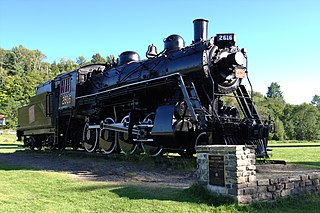
Canadian National class N-4 steam locomotives were of 2-8-0 wheel arrangement in the Whyte notation, or 1′D in UIC classification. These locomotives were built for the Grand Trunk Railway (GT) from 1906 until GT began purchasing class M freight locomotives in 1913. Initially classed D2 by the Grand Trunk, they were built as Richmond compound locomotives with 210 lbf/in2 (1.4 MPa) boilers feeding 22+1⁄2 inches (572 mm) and 35 inches (889 mm) by 32 inches (813 mm) cylinders.

Chicago and North Western 175 is a preserved R-1 class 4-6-0 "Ten-Wheeler" steam locomotive built by the American Locomotive Company (ALCO) in December 1908. The locomotive was used for pulling various passenger and freight trains throughout Wisconsin, until the Chicago and North Western (C&NW) Railroad ended commercial steam operations in 1957. In 1964, the locomotive was sold to Clint Jones, who had plans to use it on the Keweenaw Central Railroad for excursion service alongside Copper Range 2-8-0 No. 29, but restoration work was never completed under his ownership.
References
- 1 2 3 4 Robertson, Edwin B. (1977). Maine Central Steam Locomotives. Westbrook, Maine: Edwin B. Robertson. pp. 32–39.
- 1 2 3 Johnson, Ron (n.d.). Maine Central R.R. Mountain Division. 470 Railroad Club. pp. 67 & 323.
- ↑ Robertson, Edwin B. (1978). Maine Central Diesel Locomotives. Edwin B. Robertson. pp. 19&25.